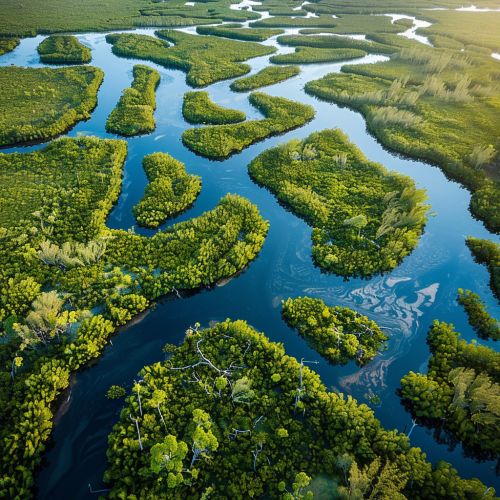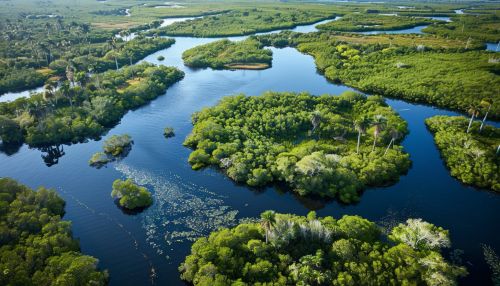Everglades
Geography
The Everglades is a natural region of tropical wetlands in the southern portion of the U.S. state of Florida, comprising the southern half of a large drainage basin within the Neotropical realm. The system begins near Orlando with the Kissimmee River, which discharges into the vast but shallow Lake Okeechobee. Water leaving the lake in the wet season forms a slow-moving river 60 miles (97 km) wide and over 100 miles (160 km) long, flowing southward across a limestone shelf to Florida Bay at the southern end of the state. The Everglades is unique in many respects, it features a complex system of interdependent ecosystems that include cypress swamps, the estuarine mangrove forests of the Ten Thousand Islands, tropical hardwood hammocks, pine rockland, and the marine environment of Florida Bay.


Ecology
The Everglades hosts a wide variety of fauna, including a number of species that are rare and endangered. The region is home to 67 threatened or endangered species, such as the Florida panther, the American crocodile, and the West Indian manatee. It is also a significant breeding ground for tropical wading birds in North America, including the roseate spoonbill, the American white pelican, and a variety of egrets and herons. The Everglades also has a rich diversity of flora, with the dominant plant communities being sawgrass marshes, coastal mangroves, and hardwood hammocks. These ecosystems are sustained by the constant flow of fresh water from Lake Okeechobee and the many rivers and streams that feed into the Everglades.
History
The Everglades has a rich cultural history. Native American tribes such as the Calusa and the Tequesta were the first to inhabit the area, followed by the Seminoles and Miccosukee. The region was largely unexplored by Europeans until the 19th century, when it became a source of bird feathers and alligator hides for the fashion industry. In the 20th century, efforts to drain the Everglades for agricultural and urban development led to significant environmental damage. Today, the Everglades is a protected area, with much of the region included in the Everglades National Park, the largest subtropical wilderness in the United States.
Conservation
The conservation of the Everglades is a significant issue in South Florida. The degradation of the Everglades has led to a decrease in its water quality due to urban and agricultural runoff, a reduction in its wildlife habitat, and a decline in its fish populations. Efforts to restore the Everglades have been ongoing since the 1980s, with the Comprehensive Everglades Restoration Plan (CERP) being the largest ecological restoration project in the world. Despite these efforts, the Everglades continues to face threats from invasive species, sea level rise due to climate change, and ongoing urban development.
